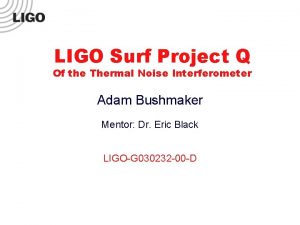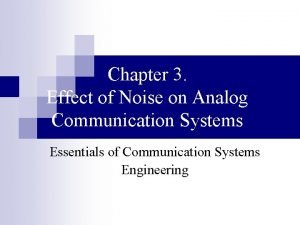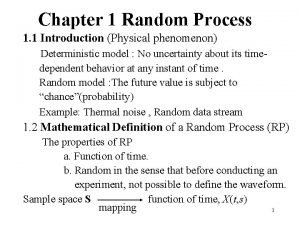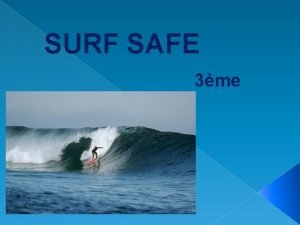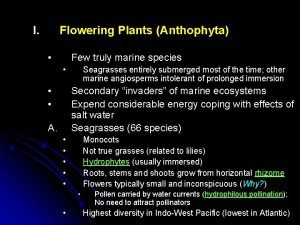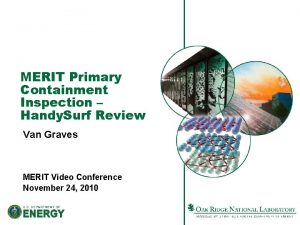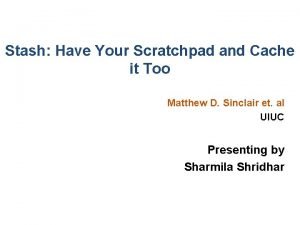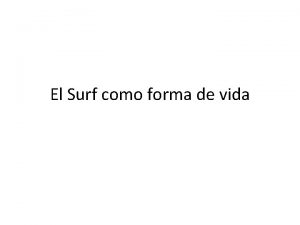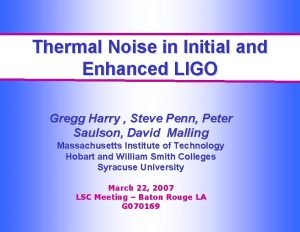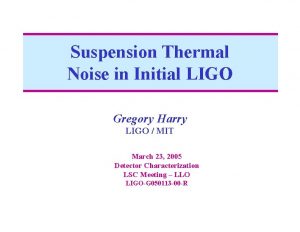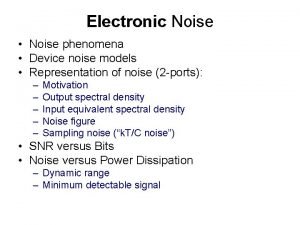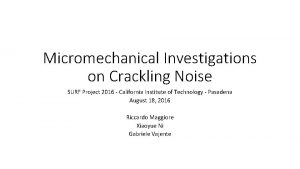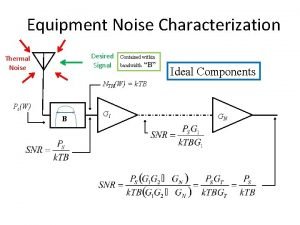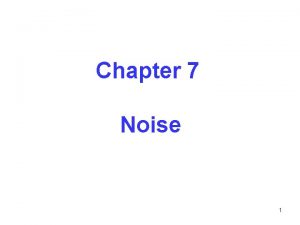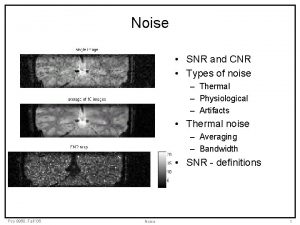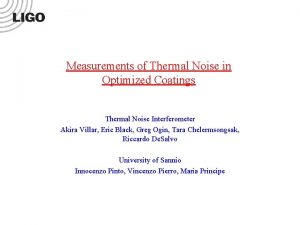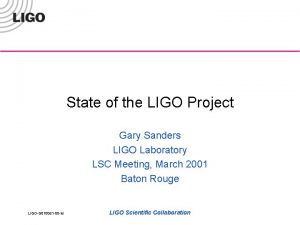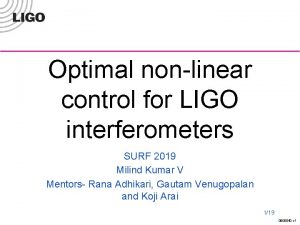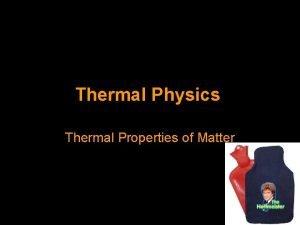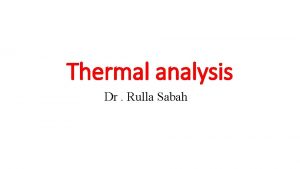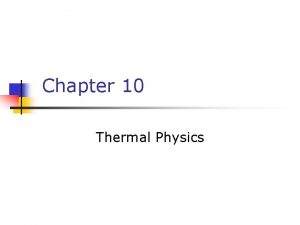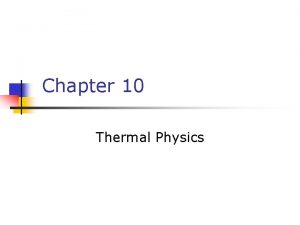LIGO Surf Project Q Of the Thermal Noise























- Slides: 23

LIGO Surf Project Q Of the Thermal Noise Interferometer Adam Bushmaker Mentor: Dr. Eric Black LIGO-G 030232 -00 -D

Why build a Thermal Noise Interferometer? Seismic Noise (Expected) Thermal Noise (Expected) Shot Noise (Expected) Thermal noise is expected to limit the sensitivity of LIGO, and other gravitational-wave detectors, over a crucial range of frequencies (~50200 Hz). Broadband thermal noise has not been studied in the high-Q mirrors and suspensions that gravitational-wave detectors use. In a small interferometer, we can isolate and study just thermal noise.

TNI Layout

Project Goals 1. ) To gain an understanding of the Mode vibrations in the fused silica and sapphire mirrors of the TNI. 2. ) To measure the Q factor in the fused silica and sapphire mirrors, so that we may be able to make testable predictions for thermal noise level in the TNI.

Mode Vibrations in the Mirrors – Part 1 Mode vibrations = resonant frequencies Understanding these vibrations is crucial, because they are included in the current model of thermal noise, which is used to predict the level of thermal noise expected.

Algor FEA Algor software uses Finite Element Analysis to predict the mode vibrations in a material with a given shape and mechanical properties. Television mode Observed modes

Drumhead vibration Mirror Laser

Algor Mode Vibration Simulation: Low Order Modes

Algor Mode Vibration Simulation: 1 st, 2 nd, 3 rd, and 4 th Drumhead Modes

Algor Mode Vibration Simulation: Higher Order, Complicated Modes

Uncertainty was calculated for the physical constants numerically, using the partial derivatives of the variables and quadrature. Uncertainty in the dimensions was calculated analytically. E = Young’s Modulus σ = Poisson’s Ratio G = Shear Modulus L = Length of mirror

An Unstable System The frequencies of these modes can ring up due to feedback though the servos, and this process can throw the Fabry-Perot cavities out of lock.

Notch Filters Lowers the Gain of the control system at the mode frequencies, so that there will be no feedback through the system. Frequencies for the sapphire mirrors must be predicted, then notch filters can be ordered.

Results for Mode Vibration Analysis All information found on this analysis will be available in a paper submitted to the Document Control Center (DCC).

The “Q” in Project Q – Part 2 The Q, or Quality factor is the measure of how much an object damps vibrations in it. A high Q means vibrations continue for a long time.

Q and thermal noise. Q is also the measure of the difference between the on and off resonance noise level in a system. High Q materials were chosen so that the noise level off resonance is low.

The Fluctuation. Dissipation Theorem This is a prediction of the fluctuation-dissipation theorem, which relates thermal energy in a material to noise levels. (Assumption of a constant loss angle Ф(ω). ) With this relation, the Q factor can be used to make testable predictions for thermal noise floor level in the TNI. Fluctuation-dissipation equation (Saulson)

Measuring the Q The Q factor is measured by ringing up the mirrors, and then watching the decay of their vibrations at the resonant frequencies. This can be done by introducing white noise at the resonant frequency electronically. Osciliscope Screenshot of a Ringdown Measuring the Ringdown in Excel using a curve fit

Results Q measurements were found to vary from 1700 to over 3 million.

Conclusions I We have accurately modeled the vibration modes of the TNI’s test masses. Observed resonant frequencies agree well with predictions. Observed mirror Q’s varied by more than three orders of magnitude. This variation was seen both between mirrors for the same mode and between modes in the same mirror. Our naïve assumptions that both Q=1/f(w) and that f(w) is constant do not appear to be valid in this system.

Conclusions II Several possibilities for explanation. -Violin mode of suspension wire. -Resonant mode in servo magnets. -Mirror Coating losses. Unknown explanation for apparent correlations.

Future Work Determining the cause of the large Q variation. Determining new model to relate Q to the level of thermal noise. Taking more Q measurements at different frequencies and on different modes.

Thanks Out To: My mentor, Dr. Eric Black Grad. Student Shanti Rao Ken Mailand And fellow SURF students, Sharon Meidt Fumiko Kawazoe Kyle Barbary And the National Science Foundation For funding my project
 My project q
My project q Companding quantization
Companding quantization White noise in analog communication
White noise in analog communication Thermal noise is a wide sense stationary process.
Thermal noise is a wide sense stationary process. Thermal noise
Thermal noise Rumus thermal noise
Rumus thermal noise Thermal energy section 3 using thermal energy
Thermal energy section 3 using thermal energy Thermal transfer vs direct thermal printing
Thermal transfer vs direct thermal printing Objectifs grammaticaux
Objectifs grammaticaux Miracosta admissions office
Miracosta admissions office Alexa internet, inc.
Alexa internet, inc. Surf grass phylum
Surf grass phylum A cook uses a cleaning towel
A cook uses a cleaning towel Surf's up flyer microsoft word
Surf's up flyer microsoft word Tension diagonal swift water rescue
Tension diagonal swift water rescue Surf in present perfect
Surf in present perfect Subway elkhorn avenue
Subway elkhorn avenue Present simple s/es
Present simple s/es How often do you surf the internet
How often do you surf the internet Let's talk about internet
Let's talk about internet Handysurf sport
Handysurf sport Mindsurf portal
Mindsurf portal Surf coast art space
Surf coast art space App surf
App surf
